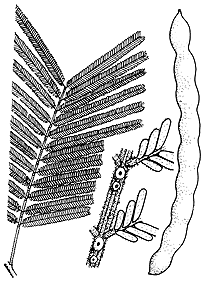Common name: black wattle
Acacia mearnsii De Wild. APNI* Synonyms: Racosperma mearnsii (De Wild.) Pedley APNI*

Description: Erect shrub or tree mostly 3–10 m high, sometimes taller; bark smooth to fissured, brown or greenish to blackish; branchlets angled to ± terete with ridges, hairy.
Leaves with petiole 0.5–2.5 cm long, hairy, 1 gland at base of or to 8 mm below lowest pair of pinnae (rarely another smaller gland); rachis 3–13.5 cm long, hairy, jugary glands present (sometimes to 1 mm below insertion of pinnae or appearing more interjugary), 1 or occasionally 2 interjugary gland(s) between all or some pairs of pinnae; pinnae 7–31 pairs, 1.5–6 cm long; pinnules 16–78 pairs, ± oblong to narrowly oblong-oblanceolate, mostly 1.5–3.5 mm long, 0.6–0.8 mm wide, ciliate, lower surface hairy to subglabrous.
Inflorescences in axillary and terminal panicles or racemes; peduncles 2–8 mm long, white- to golden-hairy; heads globose, 20–40-flowered, 6–8 mm diam., pale yellow or cream-coloured.
Pods straight to curved, ± flat, barely constricted between seeds to ± submoniliform or irregularly more deeply constricted, mostly 3–12 cm long, 4.5–8 mm wide, leathery, with minute, ± appressed hairs; seeds longitudinal; funicle expanded towards seed.
Flowering: mainly October–December.
Distribution and occurrence: south from Peats Ridge. Grows in wet sclerophyll forest, woodland and coastal scrub, on hillsides, ridgetops and creekbanks, in clay or sandy soils.
NSW subdivisions: CC, SC, CT, ST
Other Australian states: Vic. Tas. *W.A. S.A.
Named after Colonel Edgar Alexander Mearns (1856-1916), who collected the type from a cultivated specimen in East Africa. A widely cultivated and fast growing species, and is grown almost world wide as a source of tannin for leather and adhesives, for firewood, charcoal, hardboard, chipboard, Kraft paper pulp, and rayon production.
Text by P.G. Kodela (last edited May 2012)
Taxon concept: P.G. Kodela & G.J. Harden, Flora of NSW Vol. 2 (2002)
APNI* Provides a link to the Australian Plant Name Index (hosted by the Australian National Botanic Gardens) for comprehensive bibliographic data
***The AVH map option provides a detailed interactive Australia wide distribution map drawn from collections held by all major Australian herbaria participating in the Australian Virtual Herbarium project.
|


